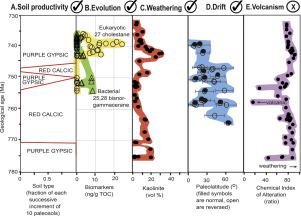当前位置:
X-MOL 学术
›
Palaeogeogr. Palaeoclimatol. Palaeoecol.
›
论文详情
Our official English website, www.x-mol.net, welcomes your feedback! (Note: you will need to create a separate account there.)
Neoproterozoic marine chemostratigraphy, or eustatic sea level change?
Palaeogeography, Palaeoclimatology, Palaeoecology ( IF 3 ) Pub Date : 2021-01-01 , DOI: 10.1016/j.palaeo.2020.110155 Gregory J. Retallack , Adrian P. Broz , Larry S.-H. Lai , Kevin Gardner
Palaeogeography, Palaeoclimatology, Palaeoecology ( IF 3 ) Pub Date : 2021-01-01 , DOI: 10.1016/j.palaeo.2020.110155 Gregory J. Retallack , Adrian P. Broz , Larry S.-H. Lai , Kevin Gardner

|
Abstract Paleosols are characterized with new chemical and petrographic data from the Tonian (776–729 Ma) Chuar Group in the eastern Grand Canyon, Arizona. Paleosols have been discovered at 66 stratigraphic levels in a 1622 m sequence largely of marine shales and thin intertidal stromatolitic dolostones. A purple paleosol association includes gypsum “desert roses” in profiles like Gypsids of hyperarid climates. A red paleosol association includes calcareous nodules profiles like Calcids of semiarid climates. Degree of weathering and phosphorus depletion of the paleosols is evidence of microbial-earth communities gaining in productivity during the Tonian. The gypsic to calcic soil transition in the modern Atacama Desert of Chile corresponds with a transition from simple actinobacterial-cyanobacterial microbial earths to complex algal-fungal communities of markedly greater weathering effectiveness and carbon sequestration. A similar change in biological weathering may have induced Snowball Earth 12 Myrs after deposition of the Chuar Group. Paleosols are found only at levels of the Chuar Group where δ13C isotopic composition of both organic matter and of carbonate are below marine and mantle values. Although such inflections in isotopic time series have been considered chemostratigraphic markers of global oceanic composition, in this case we interpret them to reflect a change in sea level from shallow marine to terrestrial. A notable inflection at about 752 Ma in the Chuar Group corresponds with the recently recognized Konnarock Glaciation of Virginia, and may have been a time of global sea-level fall. Correlation of Precambrian marine sequences by wiggle matching isotopic time series may still be effective, but because of sea-level change rather than for the chemical oceanographic reasons originally envisaged.
中文翻译:

新元古代海洋化学地层学,还是海平面变化?
摘要 利用亚利桑那州东部大峡谷 Tonian (776–729 Ma) Chuar 群的新化学和岩石学数据表征古土壤。已在 1622 m 层序中的 66 个地层级别发现古土壤,主要是海相页岩和薄的潮间带叠层白云岩。紫色古土壤协会包括石膏“沙漠玫瑰”,如极端干旱气候的吉普赛人。红色古土壤组合包括钙质结核剖面,如半干旱气候的钙质。古土壤的风化程度和磷耗竭程度是托尼阶时期微生物-地球群落生产力提高的证据。智利现代阿塔卡马沙漠的吉普赛土壤向钙质土壤转变对应于从简单的放线菌-蓝藻微生物土壤到复杂的藻类-真菌群落的转变,该群落具有显着更强的风化效果和碳固存能力。在 Chuar 群沉积后,生物风化的类似变化可能导致了 Snowball Earth 12 Myrs。古土壤仅在 Chuar 群的水平上发现,其中有机质和碳酸盐的 δ13C 同位素组成低于海洋和地幔值。尽管同位素时间序列中的这种变化被认为是全球海洋组成的化学地层标记,但在这种情况下,我们将它们解释为反映了海平面从浅海到陆地的变化。Chuar 群中大约 752 Ma 的显着拐点对应于最近确认的弗吉尼亚 Konnarock 冰川,可能是全球海平面下降的时期。通过摆动匹配同位素时间序列关联前寒武纪海洋序列可能仍然有效,但由于海平面变化而不是最初设想的化学海洋学原因。
更新日期:2021-01-01
中文翻译:

新元古代海洋化学地层学,还是海平面变化?
摘要 利用亚利桑那州东部大峡谷 Tonian (776–729 Ma) Chuar 群的新化学和岩石学数据表征古土壤。已在 1622 m 层序中的 66 个地层级别发现古土壤,主要是海相页岩和薄的潮间带叠层白云岩。紫色古土壤协会包括石膏“沙漠玫瑰”,如极端干旱气候的吉普赛人。红色古土壤组合包括钙质结核剖面,如半干旱气候的钙质。古土壤的风化程度和磷耗竭程度是托尼阶时期微生物-地球群落生产力提高的证据。智利现代阿塔卡马沙漠的吉普赛土壤向钙质土壤转变对应于从简单的放线菌-蓝藻微生物土壤到复杂的藻类-真菌群落的转变,该群落具有显着更强的风化效果和碳固存能力。在 Chuar 群沉积后,生物风化的类似变化可能导致了 Snowball Earth 12 Myrs。古土壤仅在 Chuar 群的水平上发现,其中有机质和碳酸盐的 δ13C 同位素组成低于海洋和地幔值。尽管同位素时间序列中的这种变化被认为是全球海洋组成的化学地层标记,但在这种情况下,我们将它们解释为反映了海平面从浅海到陆地的变化。Chuar 群中大约 752 Ma 的显着拐点对应于最近确认的弗吉尼亚 Konnarock 冰川,可能是全球海平面下降的时期。通过摆动匹配同位素时间序列关联前寒武纪海洋序列可能仍然有效,但由于海平面变化而不是最初设想的化学海洋学原因。



























 京公网安备 11010802027423号
京公网安备 11010802027423号